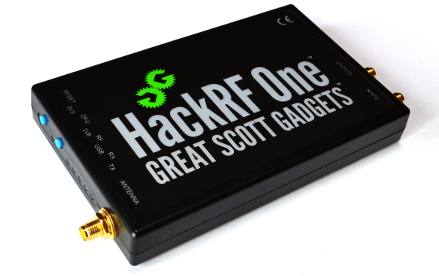Written By: Nisita C.
What is Software-Defined Radio (SDR)?
Software-Defined Radio (SDR) revolutionizes the way we interact with radios by transforming traditional hardware components like knobs, dials, and switches into software-controlled elements. This advancement significantly enhances the usability of radios with computers, making “HackRF One” a standout example of this technology in action.
HackRF One
“HackRF One” is a beacon in the SDR landscape, an open-source hardware platform created by Great Scott Gadgets. This half-duplex transceiver shines in the wide-band SDR arena, crafted to explore modern radio technologies. Whether used as a USB peripheral or a stand-alone device akin to a computer’s sound card, HackRF One embodies the spirit of innovation. Its open-source nature draws a diverse community of hackers, radio enthusiasts, and cybersecurity experts. For more insights, visit the Great Scott Gadgets website
HackRF One’s Impressive Features
HackRF One boasts an impressive feature set, capable of sending and receiving signals from 1 MHz to 6 GHz, with sample rates from 2 Msps to 20 Msps. It supports an 8-bit resolution and connects via a high-speed USB interface with a Micro-B connector, drawing power directly from the USB bus. Key attributes include a software-controlled antenna port, an SMA female antenna connector, and clock inputs/outputs for synchronization. With user-friendly design elements like programming buttons, portability, expansion pin headers, and open-source software, HackRF One is accessible to everyone at no extra cost.
HackRF One opens up many potential projects across various fields, including communications, cybersecurity, education, and hobbyist electronics. Here are several project ideas that illustrate the versatility of HackRF One:
FM Radio Broadcasting:
Use HackRF One to create a low-power FM radio station for educational purposes. One can learn about FM transmission and radio broadcasting principles by transmitting audio content within legal limits.
RFID Cloning and Research:
Experiment with cloning RFID tags and analyzing RFID signals. This project can deepen understanding of RFID technology and its security implications, which are crucial for cybersecurity research.
GPS Spoofing:
Conduct a controlled experiment to understand how GPS signals can be spoofed, affecting GPS receivers within the range. This project should be undertaken with a strong understanding of legal and ethical boundaries, as GPS spoofing can have serious implications.
Digital Voice Modulation:
Experiment with digital voice modulation techniques, such as DMR, D-STAR, or Fusion, widely used in amateur radio. This project can help us understand how voice data is encoded, transmitted, and decoded over radio waves.
Satellite Signal Reception:
Receive and decode satellite signals, such as those from weather satellites or amateur radio satellites. This project offers insights into satellite communication and can be particularly rewarding by receiving real-time satellite images of Earth.
Wireless Security Research:
HackRF One can be a powerful tool for understanding wireless security vulnerabilities. Projects can include analyzing Wi-Fi networks for vulnerabilities, understanding the security mechanisms of Bluetooth devices, or exploring new security protocols.
Educational Tools for Schools:
Develop interactive tools or demonstrations to teach students about radio frequency (RF) technology, signal processing, and communications principles. HackRF One can make abstract concepts tangible for learners of various ages.
Creating a Mesh Network:
With multiple HackRF One devices, one could experiment with creating a mesh network, allowing for direct, peer-to-peer communication between nodes. This can be a learning project for understanding the complexities and potential of decentralized network communication.
Starting with HackRF One
To start with HackRF One, users must install the basic HackRF utilities, which are available in many Linux distributions, including Ubuntu. It’s crucial to update your HackRF One with the latest firmware. Applications like CubicSDR, accessible for Linux, offer an intuitive way to control HackRF One. Upon launching CubicSDR and connecting the device, users can delve into various signals, from AM and FM stations to adjusting the bandwidth for clear signal reception. This introduction to HackRF One only scratches the surface of what’s possible with SDR, prompting further exploration through applications like GNU Radio, gqrx, and SDRSharp. Learn more on the GNU Radio project page




